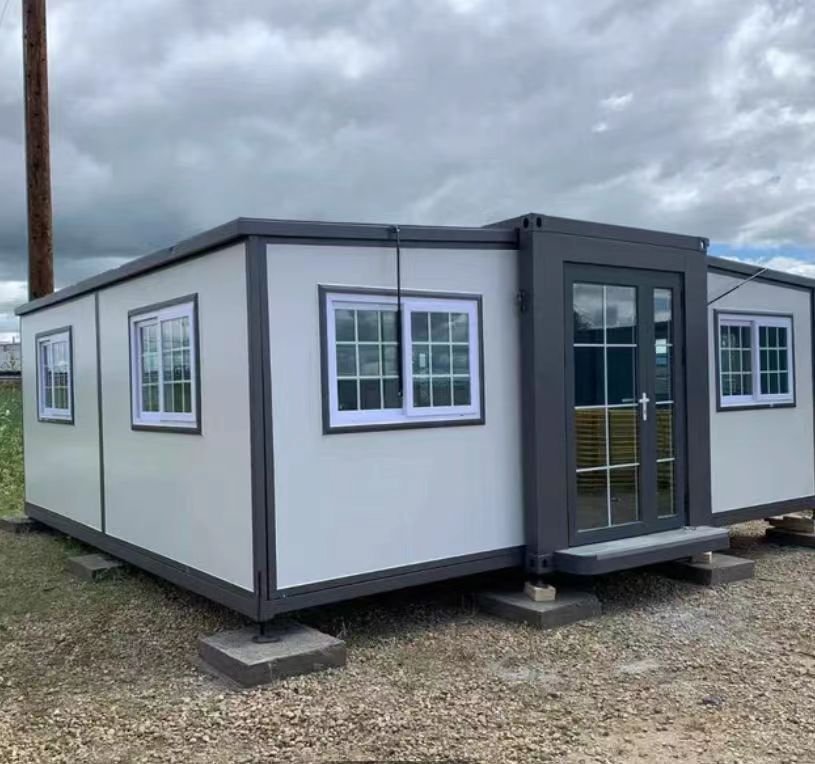When you build a container house, it’s a pretty big deal, right? It’s a super cool thing to do, but all you know is you want to do your container house right, and it's hard to figure out if what people are using is good. Have you ever looked at your project and wondered “Is that the right steel for me or not?” Whether it’s strength, whether it’s longevity, or whether it’s money, whether carbon steel or cast steel, the type of steel you use in your container house is really important for how good your project will be and how long it will last. Let’s figure it out together.

We’ve been building container houses now for several years and doing modular construction for a long time. People ask me questions everyday about what we use and how to do it.
One of the biggest questions I get is “What is the difference between carbon steel and cast steel?”
So, now I’m going to tell you so you can decide what questions you need to be asking for yourself.
Differences between Carbon Steel and Cast Steel
1. What They’re Made Of
- Carbon Steel:
Carbon steel is an iron-carbon alloy containing anywhere from a fraction of a percent (0.0180%) to a 2.11% carbon. Different carbon contents affect the hardness and strength at different temperatures—higher carbon content equates to harder but more brittle steel. It also includes small amounts of other elements like manganese and silicon to slightly alter their mechanical properties. - Cast Steel:
Cast steel is a type of carbon steel that has less carbon (somewhere between 0.1% and 0.5%) and also has extra stuff thrown in. That extra stuff makes it more impact resistant, tougher, and, in general, you can do more with it and it won’t break when you do it.
2. What They Are Like
- Strength and Hardness:
Carbon steel typically has greater hardness and tensile strength, which probably helps if you are going to use it for structural purposes where you might put a load on it. Cast steel, on the other hand, has better toughness and can absorb energy better without fracturing, which is particularly good if you are using it for something that gets hit all of a sudden. - Ductility:
Cast steel is easier to make do what you want without it breaking, which makes it particularly useful if you’re going to be doing something like bending it or if parts are hanging it or if you’re going to be putting a big load on it. High-carbon steel, on the other hand, doesn’t bend as well as it, and it doesn’t like to be strained. - Weldability:
Cast steel tends to weld a little better than carbon steel because it’s not as hard. That’s really important in container houses because you’re welding all kinds of stuff to the stuff.
3. Where You Use Them in Your Container House
- Carbon Steel:
You probably put that in the big stuff where you put a load on the stuff—like beams and supports that hold up the stuff. - Cast Steel:
You put that where you have to make a joint, where you have to curve it or where it can break if you hit it really hard or where you need to do it out of something that doesn’t like to be straight.
4. How Much Money You’re Going to Spend
Yes, cast steel costs more. You have to make cast steel out of different things, and you have to throw it in a mold. It costs more money. Not to mention, you can do some crazy stuff when the stuff is still in the mold. But, that’s a whole another conversation.
But here’s the deal. Spend the money if you need to spend the money. Don’t spend the money if you don’t have to spend the money. Spend the money if you need cast steel. Don’t spend the money if you will never need cast steel. If you’re looking at stuff and you’re trying to decide if you go with one steel or the other, figure out what you need the steel to do, and then you’ll know what to buy.
There you go.
Taking It a Step Further
Now that you know that, let me tell you about a couple of things you’re probably thinking about.,
“ Which one of these does better outside?”
“ If I pay more money for cast steel, do I have to pay more to take care of it or something?”
“What does this mean for the planet?”
“What does it weigh?”
If you want to know the answer to those questions, get ready. I’m going to tell you right now.
1. What Material Works Best Outside for Container Houses?
Depends on how good the stuff is at keeping itself from rusting, staying where it is and not getting beat all to hell because of the way the wind or the sleet or whatever is. Answer:
- Carbon Steel:
You need something to break the rust for it if you put this outside. Especially if you put it outside in places that are nasty— places that are brown with the stuff (rust). - Cast Steel:
- You don’t have to take care of it as much because it’s tougher. But you probably need to keep it from rusting if you have it outside all the time with no way to keep it from getting wet.
- With cast steel, wherever it’s always hot and cold five minutes later, I would put some of that stuff on it.
In environments with extreme weather fluctuations, cast steel’s flexibility gives it a slight edge.
2. Does Cast Steel Cost More for Container Houses?
Yes, cast steel costs more. You have to make cast steel out of different things, and you have to throw it in a mold. It costs more money. Not to mention, you can do some crazy stuff when the stuff is still in the mold. But, that’s a whole another conversation.
But here’s the deal. Spend the money if you need to spend the money. Don’t spend the money if you don’t have to spend the money. Spend the money if you need cast steel. Don’t spend the money if you will never need cast steel. If you’re looking at stuff and you’re trying to decide if you go with one steel or the other, figure out what you need the steel to do, and then you’ll know what to buy.
There you go.
3. Maintenance?
- Carbon Steel:
Look at it, and if it starts to change colors, paint it some more. Weather and something without a bunch of people at it will mess stuff up. - Cast Steel:
It will last longer before you goof off with it, but you still need to put stuff on it to keep it from turning brown.
4. For the Environment:
- Bunch of People Stuff:
Making the straightforward stuff is easier on the place where we live. However, it rusts if you don’t take care of it, so you will toss more of it away over time. - Fancy Cast Steel Stuff:
ou put more than regular things in it, making the world hotter. But if it never wears out, you will not have to throw it away. Call and ask Green People how to fix this conundrum.
5. How Heavy is the Stuff I’m Buying?
Weight is a crucial factor in modular construction:
- Carbon Steel:
More dense equal more stuff in the same area. You can put it stuff where you need that. It also helps stick stuff together. However, you can’t pick it up with your toe. - Cast Steel:
Lighter stuff is just as tough, letting you move it around and use it in places where regular steel will not work.
Finally, making a decision between carbon steel and cast steel for container houses comes down to what you’re doing with whatever you’re making. If you’re making big stuff that goes straight, you probably need carbon steel. If you’re doing other stuff that’s got joints and curves and has to be tough and won’t break and do other stuff, you need to use cast steel.
Keep doing big stuff. Keep being tough. Keep saving money for today and reducing your problems tomorrow. And when you are ready to do your container house, call us or email us, and we’ll tell you everything you need to know to do your container house right. Because it matters today, and it matters for your future.
There you go.



